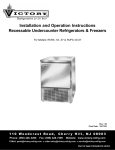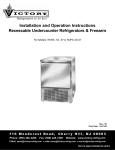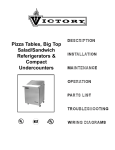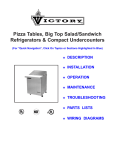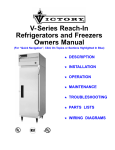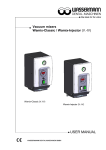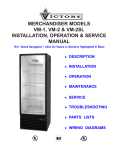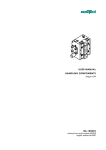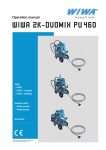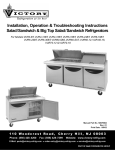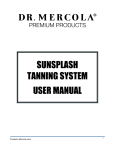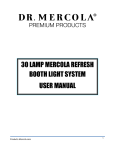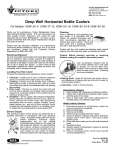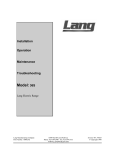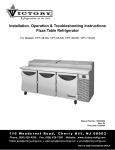Download GRS & GFS End User Manual.qxd
Transcript
Refrigeration at its best Installation and Operation Instructions Griddlestand Refrigerators & Freezers For Models: GFS-1D-S7, GFS-2D-S7, GFS - 3D - S7, GRS-1D-S7, GRS-2D-S7 & GRS-3D-S7 Rev: 00 Print Date: 3/3/05 110 Woodcrest Road, Phone: (856) 428- 4200 Cherry Hill, NJ 08003 Fax: (856) 428-7299 E-Mail: [email protected] ● Website: www.victory-refrig.com [email protected] ● [email protected] PART OF AGA FOODSERVICE GROUP T H A N K Y O U Thank you for purchasing a Victory Refrigeration Griddle Stand Refrigerator or Freezer! This unit has passed our strict Quality Control Inspection and meets the high standards set by Victory Refrigeration. You have made a quality investment that with proper maintenance will give you years of service. Please read the following installation and maintenance instructions before installing or using your unit. If you have any questions, please call our Customer Service Department at (856) 428-4200. IMPORTANT INFORMATION - PLEASE READ ● Please read these instructions carefully before installing or using. If recommended procedures are not followed, warranty claims will be denied. ● Your Warranty Registration information is located on the next page of this manual. Please complete the card and submit it to Victory Refrigeration within 10 days of installation. Failure to properly register equipment can void the warranty. ● Victory Refrigeration reserves the right to change specifications and product design without notice. Such revisions do not entitle the buyer to corresponding changes, improvements, additions or replacements for previously purchased equipment. Warranty (Continental USA Only) The Seller warrants to the original purchaser, equipment manufactured by Seller to be free from defects in material and workmanship for which it is responsible. The Seller's obligation under this warranty shall be limited to replacing or repairing at Seller's option, without charge, F.O.B. Sellers factory, any part found to be defective and any labor and material expense incurred by Seller in repairing or replacing such part, such warranty to be limited to a period of one year from date of purchase or thirteen months from date of shipment from Seller's factory, whichever is earlier, provided terms of payment have been fully met. All labor shall be performed during regular working hours. Overtime premium charges will be at Buyer's expense. Proof of purchase must be supplied to Seller to validate warranty. This warranty is valid only if equipment is properly installed, started-up and inspected by the dealer or authorized Victory Service agent. Removal or alteration of the serial/data plate from any equipment shall be deemed to release Seller from all warranty obligations or any other obligations, expressed or implied. This warranty does not cover Thermostat or Defrost Timer calibration and/or adjustment, freight damage, normal maintenance items outlined in Owner's Manual, adjustment of door mechanisms or replacement of light bulbs, fuses or batteries. Any repairs or replacement of defective parts shall be performed by Seller's authorized service personnel. Seller shall not be responsible for any costs incurred if the work is performed by other than Seller's authorized service personnel. Reimbursement claims for part(s) or labor service costs must be made in writing. Model, cabinet serial numbers and installation location must be shown on the claim. A receipted bill from the servicing agency must accompany the claim, together with full details of the service problems, diagnosis and work performed. Victory reserves sole discretion whether further documentation on a claim is to be submitted. Seller shall not be liable for consequential damages of any kind which occur during the course of installation of equipment, or which result from the use or misuse by Buyer, its employees or others of the equipment supplied hereunder, and Buyer's sole and exclusive remedy against Seller for any breach of the foregoing warranty or otherwise shall be for the repair or replacement of the equipment or parts thereof affected by such breach. The foregoing warranty shall be valid and binding upon Seller if and only if Buyer loads, operates and maintains the equipment supplied hereunder in accordance with the instruction manual provided to Buyer. Seller does not guarantee the process of manufacture by Buyer or the quality of product to be produced by the equipment supplied hereunder and Seller shall not be liable for any prospective or lost product or profits of Buyer. THE FOREGOING WARRANTY IS EXCLUSIVE AND IN LIEU OF ALL OTHER EXPRESS AND IMPLIED WARRANTIES WHATSOEVER. SPECIFICALLY THERE ARE NO IMPLIED WARRANTIES OF MERCHANTABILITY OR OF FITNESS FOR A PARTICULAR PURPOSE. The foregoing shall be Seller's sole and exclusive obligation and Buyer's sole and exclusive remedy for any action, whether in breach of contract or negligence. In no event shall Seller be liable for a sum in excess of the purchase price of the item. You may register online at www.victory-refrig.com, fax this completed page to (856) 428-7299, or copy and mail form below to Victory. *NOTE: The following mail-in form or online registration must be filled out and forwarded to Victory by the installer or customer within 10 days after start-up. Failure to do this will invalidate the warranties. Retain this information for your records. 110 WOODCREST ROAD CHERRY HILL, NJ 08003-3648 TEL: (856) 428-4200 ● FAX: (856) 428-7299 WARRANTIES NOT VALID UNLESS REGISTERED AT FACTORY WITHIN 10 DAYS AFTER START-UP DATE. Cabinet Model No.______________________ Cabinet Serial No._________________ (Data plate information located inside cooler on the upper left wall) ORIGINAL DATE OF INSTALLATION __________________________________________________________________ INSTALLATION COMPANY NAME ____________________________________________________________________ STREET _______________________________ CITY _____________________ STATE ______ ZIP CODE___________ DISTRIBUTOR’S NAME_____________________________________________________________________________ STREET _______________________________ CITY _____________________ STATE ______ ZIP CODE___________ IMPORTANT OPERATING FACTS Your new model is completely self-defrosting. Frost is automatically removed from concealed coil finned surfaces at predetermined intervals. All defrost condensate water is directed to a vaporizer and is disposed of automatically, no floor drain is required. REMOVING DOORS If necessary the doors may be removed in order to pass through a narrow doorway: 1. Remove hex cap screws on edge of door. 2. Remove door from hinges. A fan motor circulates cold air throughout the fresh food and freezer storage compartments. This provides more uniform temperatures and very rapid recovery to proper operating temperatures after door opening, with its admission of warm room air. REMOVAL OF DRAWER ASSEMBLY 1. Remove drawers from cabinet by pulling the drawer forward and lifting rollers out of notched front end of slide. 2. Push slide back so that slide support rollers clear retaining strap. Lift out left hand and right hand slides. 3. Lift front end of slide support channels to disengage rivets from keyhole slots in front of mounting bracket. Pull forward slightly to disengage rear rivets from keyholes in rear bracket. Lift out side support channel. 4. Remove screws holding front brackets on both sides of tank. 5. Rear brackets may be taken out if necessary by removing thumb screws holding them to the sides of tank. The length of time required to remove the "heat" admitted due to prolonged or frequent door openings or the "heat" from a product load is dependent upon several factors. One is the amount of heat introduced into the cabinet due to duration and frequency of door openings; another is the temperature and size of the load being refrigerated. For example, placing a hot load in a refrigerator or freezer will definitely cause the thermometer pointer to rise to and remain in the danger zone for a prolonged period of time. This is normal and must be expected. However you should be concerned if the thermometer indicates danger and the door(s) have NOT been opened or a warm product load has NOT been placed in the freezer or refrigerator. This may indicate a malfunction. Continued use of this equipment will allow you to become famiIiar with its operation and functions. YOUR NEW STORAGE FREEZER OR REFRIGERATOR The following conditions should be considered when selecting a location for your refrigerator or freezer. ● Floor Load The floor on which the refrigerator or freezer will rest must be free vibration and suitably strong enough to support the combined weights of the refrigerator/freezer plus the the maximum product load which might be placed into it. To estimate the possible product load weight, it is generally conceded that a safe figure is 35 pounds for each net cubic foot of storage space. For example, a 10 cubic foot refrigerator could possibly hold approximately 350 pounds of products (10 x 35 = 350). ● Ventilation The air cooled, self-contained refrigerator or freezer demands a sufficient amount of cool clean air. Avoid placing the refrigerator or freezer near heat generating equipment, such ovens, ranges, heaters, fryers, steam kettles, etc., and out of direct sunlight. Avoid locating the self-contained refrigerator or freezer in an unheated room or where the room temperature may hover below 55°F. IMPORTANT VENTILATION NOTE 1. Do not remove the rubber bumper spacer from the rear of the cabinet. The bumper guarantees sufficient air circulation to the condensing unit. INSTALLATION OF DRAWER ASSEMBLY Reverse all above procedures. INSTALLING LEGS Correct installation is very important to proper operation. This model must be - Level When It Is Installed. If cabinet is not level ... 1. Doors may not seal properly. 2. Defrost water may overflow coil drain pan. 3. An excessive amount of ice may accumulate in coil drain pan of freezer model. This model is supplied with adjustable type legs for leveling purposes. Legs are packaged and taped with the cabinet for shipment. The legs must be secured to the leg braces on the underside of the cabinet. The legs should be installed immediately, after shipping crate bottom of skid has been removed. Tip the model in one direction, block it from falling by using several pieces of 2 x 4 lumber or other suitable material. Install legs securely while the model is in that position. Repeat this procedure to install the remaining two legs. INITIAL CLEANING OF CABINET CAUTION : DO NOT USE VOLATILE CLEANING SOLVENTS. Never scour any part of your new refrigerator or freezer. Scouring powders or chemicals may cause damage by scratching or dulling the gleaming surface finish of your new model. Prior to placing your new cabinet into operation, it is advisable that the interior be washed thoroughly with a mild detergent and water solution. Rinse with clear water and a sanitizing solution. Allow cabinet to air dry. PERIODIC CLEANING It is more convenient to clean your refrigerator or storage freezer when the product load is at its lowest point. PROPER DETERGENT USE Follow requirements of local health authorities. 1. Use a detergent-sanitizer or a mild detergent (neutral or mildly alkaline recommended for metal surfaces) followed by a sanitizing rinse solution. These chemicals are necessary to kill or deactivate the micro-organisms on the surface areas in contact with stored food. Choose these chemicals carefully. Some are toxic and should only be used on non-food surfaces. 2. Quats (quaternary ammonium) are usually the best sanitizing compounds, for they are relatively noncorrosive and have better detergent and deodorizing properties than chlorine or iodine compounds. 3. When using these products, it is important to follow label directions exactly to obtain the correct sanitizing action. 4. Caution: do not use volatile cleaning solvents. RECOMMENDED CLEANING PROCEDURE Interior Accessory Cleaning Interior cleaning is recommended a minimum of once a week to maintain good sanitary conditions and to eliminate odors. 1. Remove all food to protective temporary storage. 2. Disconnect power (electric) cord from receptacle or trip circuit breaker. 3. Open doors and allow warm room air to enter cabinet. 4. Remove all accessories (shelves, racks, etc.)fromwithin the cabinet and scrub with a detergent solution and a nylon bristled brush. 5. Rinse with clear water. 6. Soak in a final rinse of sanitizing solution for recommended period of time. 7. Remove and air dry. Interior Surface Cleaning 1. When storage compartment(s) is sufficiently warm, remove all loose food particles. 2. Scrub all interior surfaces with warm detergent solution 100-120°F (38-49°C) and a nylon bristled brush. Scrub the floor and ceiling surfaces of the interior, walls, corners, inner door surface, gaskets, and latches. 3. Rinse with warm clean water using a cellulose sponge. 4. Remove excess rinse water with sponge. 5. Wipe all interior surfaces down with sanitizing solution. 6. Allow to air dry. 7. Return accessories to unit. 8. Return power (electrical) cord to receptacle or reset circuit breaker. 9. Return food to cabinet when temperature indicator reaches safety zone. Exterior Surface Cleaning Cleaning and sanitizing agents for stainless steel and aluminum exteriors should be used daily. 1. Dip cellulose sponge in cleaning solution, wipe down surfaces. 2. Polish with clean soft cloth. Wipe in direction of grain. Once a week a film cutting agent may be used for metal finishes to maintain a shining surface. Condenser Maintenance Cleaning is recommended at least once every three (3) months. 1. Disconnect the electrical service cord from receptacle or trip circuit breaker. 2. Use a vacuum cleaner with proper brush attachments, to clean the condenser, compressor motor and related parts. 3. In extreme cases of dust and grease build-up, the condenser fins may require blowing out with compressedair. 4. Return electrical service cord to receptacle or reset circuit breaker. NOTE: The air cooled condensing unit depends upon the amount of air passing through the condenser. Grease, lint and dust accumulation reduces required air flow. The refrigerator will consume less current and operate more efficiently if the condenser is kept clean. START-UP PROCEDURE After the model has been installed, leveled and cleaned as described in the preceding paragraphs, refer to the following check list prior to start-up. ● Full voltage of the correct type, on a line not affected fay the operation of other electrical appliances, "must be available at the condensing unit junction box during operation. Condensing units are designed to operate with a voltage fluctuation of plus or minus 10% of the voltage indicated on the cabinet electrical data plate. Burnout of a condensing unit due to exceeding the high or low voltage limits will void the factory warranty. ● Check all refrigeration lines to make sure they are not severely dented, kinked or rubbing. ● If compressor is equipped with external mounts, back off the hold down nuts to allow compressor to "float" freely on springs. ● Check condenser fan for freedom to rotate without striking any stationary members. ● Cabinet must be properly leveled. ● Leak test all exposed tubing connections of refrigeration system. Do not become alarmed if a trace of freon gas is detected in the internal cabinet air. This may be due in the freon used in expanding the foam insulation used in this cabinet. NOTE: All motors are lifetime oiled and sealed. All selfcontained models are shipped from the factory with valves opened ready for operation. EXPANSION VALVE Some models are available as remotes and are equipped with an expansion valve system. The expansion valve is located within the evaporator coil housing with both liquid and suction lines extending out from the rear of the cabinet. If the expansion valve needs to be replaced, it should be done by qualified personnel of a competent refrigeration company. LOCATION OF SERIAL NUMBER/DATA PLATE The serial data plate is mounted on the upper left interior tank wall inside the cabinet. NOTE: When ordering replacement pars you must include the complete cabinet model and serial numbers. TROUBLESHOOTING & SERVICING REFRIGERATION SYSTEM PROBLEM 1. Condensing unit fails to start - no hum. 2. Condensing unit fails to start hums, but trips on overload protector. POSSIBLE CAUSE 1. Line disconnect switch open. 2. Fuse removed or blown. 3. Overload protector tripped. 4. Control stuck in open position. 5. Wiring improper or loose. 1. Close start or disconnect switch. 2. Replace fuse. 3. Determine reason and correct/replace control. 4. Repair or replace control. 5. Check wiring against diagram. 1. 2. 3. 4. 1. 2. 3. 4. Improperly wired. Low voltage to unit. Starting capacitor defective. Relay failing to close. 5. Compressor motor has a winding open or shorted. 6. Internal mechanical trouble in compressor. 3. Condensing unit starts, but fails to switch off of “start” winding. 1. Improperly wired. 2. Low voltage to unit. 3. Relay failing to open. 4. Run capacitor defective. 5. Excessively high discharge pressure. 6. Compressor motor has a winding open or shorted. 7. Internal mechanical trouble in compressor. 4. Condensing unit starts and runs, but short cycles on overload protector. 1. Additional current passing through overload protector. 2. Low voltage to unit (or unbalanced if three phase.) 3. Overload protector defective. 4. Run capacitor defective. 5. Excessive discharge pressure. 6. Suction pressure too high. 7. Compressor too hot - return gas. 8. Compressor motor has a winding shorted. 5. Condensing unit runs but short cycles on... 1. Overload protector. 2. Thermostat. 3. High pressure cut-out due to: a. Insufficient air or water supply. b. Overcharge. c. Air in system. 4. Low pressure cut-out due to: a. Liquid line solenoid leaking. b. Compressor valve leak. c. Undercharge. d. Restriction in expansion device. 6. Condensing unit operates for prolonged periods or continuously. REMEDY 1. Shortage of refrigerant. 2. Control contacts stuck or frozen closed. 3. Excessive heat load placed into cabinet. 4. Prolonged or too frequent door openings. 5. Evaporator coil iced. 6. Restriction in refrigeration system. 7. Dirty condenser. 8. Filter dirty. Check wiring against diagram. Determine reason and correct. Determine reason and replace. Determine reason and correct/replace if necessary. 5. Replace compressor. 6. Replace compressor. 1. Check wiring against diagram. 2. Determine reason and correct. 3. Determine reason and correct/replace if necessary. 4. Determine reason and replace. 5. Check discharge shut-off valve, possible overcharge, or insufficient cooling on condenser. 6. Replace compressor. 7. Replace compressor. 1. Check wiring diagram. Check for added fan motors, pumps, etc. connected to wrong side of protector. 2. Determine reason and correct. 3. Check current , replace protector. 4. Determine reason and replace. 5. Check ventilation, restrictions in cooling medium, restrictions in refrigeration system. 6. For salad models, temperature control differential set to closeincrease differential. 7. Check refrigerant charge (fix leak) add if necessary. 8. Replace compressor. 1. See (4) above. 2. Differential set too close - widen. 3. a. Check air or water supply to condenser-correct. b. Reduce refrigerant charge. c. Purge. 4. a. Replace. b. Replace. c. Fix leak, add refrigerant. d. Replace device. 1. Fix leak, add charge. 2. Clean contacts or replace control. 3. Allow unit sufficient time for removal of latent heat. 4. Plan or organize schedule to correct condition. 5. Defrost. 6. Determine location and remove. 7. Clean condenser. 8. Clean or replace. TROUBLESHOOTING & SERVICING REFRIGERATION SYSTEM PROBLEM 7. Start capacitor open or shorted blown. POSSIBLE CAUSE 1. Relay contacts not opening properly. 2. Prolonged operation on start cycle due to: a. Low voltage to unit. b. Improper relay. c. Starting load too high. 3. Excessive short cycling. 4. Improper capacitor. 8. Run capacitor open, shorted or blown. 1. Improper capacitor. 9. Relay defective or burned out. 1. 2. 3. 4. 2. Excessively high line voltage (110% of rated-max.) Incorrect relay. Incorrect mounting angle. Line voltage too high or too low. Excessive short cycling. 5. Relay being influenced by loose vibrating mounting. 6. Incorrect run capacitor. REMEDY 1. Clean contacts or replace relay if necessary. 2. a. Determine reason and correct. b. Replace. c. Correct by using pump down arrangement if necessary. 3. Determine reason for short cycling (see 5 above) and correct. 4. Determine correct size and replace. 1. Determine correct size and replace. 2. Determine reason and correct. 1. 2. 3. 4. Check and replace. Remount relay in correct position. Determine reason and correct. Determine reason (see 5 above) and correct. 5. Remount rigidly. 6. Replace with proper capacitor. 10. Product zone temperature too high. 1. Control setting too high. 2. Inadequate air circulation. 1. Reset control. 2. Rearrange product load to improve air circulation. 11. Suction line frosted or sweating. 1. Overcharge of refrigerant. 2. Evaporator fan not running. 3. If remote model, expansion valve stuck open. 4. If remote model expansion valve is passing excess refrigerant or is oversized. 1. Correct charge. 2. Determine reason and correct. 3. Clean valve of foreign particles. Replace if necessary. 4. Readjust valve or replace with smaller valve. 12. Liquid line frosted or sweating. 1. Restriction in dehydrator or strainer. 2. Liquid shut-off (king valve) partially closed. 1. Replace part. 1. 2. 3. 4. 1. 2. 3. 4. 13. Noisy condensing unit. Loose parts or mounting. Tubing rattle. Bent fan blade causing vibration. Fan motor bearings worn. 2. Open valve fully. Find and tighten. Reform to be free of contact. Replace blade. Replace motor.







